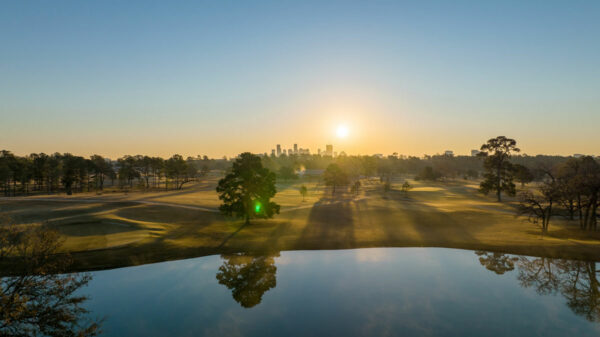
History of Austin’s Iconic Buildings
Driskill Hotel
With a rich history and rumors of ghost encounters, the Driskill Hotel, owned by Hyatt, has been part of Austin’s entertainment scene, history and hospitality for more than a century. Awaiting at the hotel are 189 guest rooms — and several other storied spaces and meeting rooms. Built in 1886 and located off 6th street, the hotel stands in the heart of Austin’s nightlife and live music. Iconic charm is seen throughout both the exterior and interior of the building with architecture inspired by the Romanesque movement with what some people call a “cowboy” touch. Elaborate porticos, arched openings and elegant interiors are embraced throughout the property.
Named the most haunted spot in Texas, the Driskill is also the oldest operating hotel within the entire state. The haunted rumor
stems from several reported tragic deaths centuries ago at the Driskill — some which involve room 525.
Some other unique aspects of the Driskill include three onsite restaurants, The Driskill Bar and 1886 Café and Bakery, and Grill.
Moonlight towers Austin’s iconic buildings.
Moonlight Towers
The only 17 surviving moonlight towers in the world are also located in Austin. These 165-foot-tall towers still actively support outdoor lighting for parts of the city. Built in 1895 using power from Austin’s first power plant on the Colorado river, the towers carbon arc lamps used to be lit manually every night by a worker who took an elevator to the top of them.
Paying tribute to the Moonlight Towers, Austin’s “Christmas tree” in Zilker Park is a replica of the towers, serving as an iconic reminder of the city’s past, present and assumed future.
The Paramount Theatre Austin’s iconic buildings
The Paramount Theatre
If the walls of the Paramount Theatre could talk, they’d have thousands of stories to tell regarding iconic films and performances gracing the stage since 1915. Harry Houdini, Katharine Hepburn and Miles Davis are just some historic names who performed at the theatre in the heart of downtown Austin on Congress Ave. Another fun fact about The Paramount is that it’s home to an original fire curtain which was discovered hanging in the rafters of the theatre in 1974. In pristine condition, the rafter is considered the oldest remaining fire curtain in the U.S.
Now a 501(c)(3) nonprofit, preservation is a priority at the historic theatre due to its Neo-classical design that came from a Chicago architect. John Eberson built around 1,200 theatres in his lifetime, and today Austin’s Paramount is one of only 25 of those structures that remain.
Lundberg Bakery Austin’s iconic buildings
Lundberg Bakery
(now Old Bakery and Emporium art gallery)
Also located on Congress Avenue and about half a block from the State Capitol, Lundberg Bakery, also known as the Old Bakery and Emporium, has a rich history that now includes honoring present-day artists.
Once a favorite bakery of draftsmen who worked in the General Land Office building, the Lundberg bakery is now designated as an historic building. Made with limestone and brick facade, an artistic eagle with perched wings also sits on top of the building that was built in the 1870s.
In the 1970s, the building was set to be torn down. But workers discovered stone used in the original State Capitol within neighboring buildings, and as a result, officials decided to save the Lundberg Bakery.
Today, under the name of Old Bakery and Emporium, Austinites and tourists can visit the facility to browse local, original, handmade art and enjoy sandwiches, coffee and drinks. Another unique feature? The art is primarily produced by artists over the age of 50.
Neill-Cochran House Museum Austin’s iconic buildings
You may also like Women Of Influence: Four Austin Women Bringing Designs To Life
Neill-Cochran House Museum
Located a few minutes from the University of Texas campus, the Neill Cochran House originally opened as a residence in 1856.
Showcasing a darker side to our city’s past, the property includes the only intact former slave dwellings within Austin. By visiting the slave quarters building of Neill Cochran, anyone in Austin is able to observe and experience the past through an immersive experience. Museum guides tell the stories of specific enslaved people who lived at Neill Cochran, including Jacob Fontaine, who founded the first black newspapers west of the Mississippi river.
One of the museum’s exhibits, “Reckoning with the Past: The Untold Story of Race in Austin” honors the contributions of every man, woman and child involved in these stories of a difficult past, how we reached a brighter future and information to learn from history so we don’t repeat the past.
A historic example of Greek architecture, the Neill Cochran House is one of Austin’s few antebellum period buildings and features prominent Doric columns on the outside of its structure.
Historic Hyde Park Homes Austin’s iconic buildings
Historic Hyde Park Homes
One of the city’s most historic neighborhoods, Hyde Park homes started to be built in 1891. Located just north of downtown, homes are lined with older trees, contributing to streets filled with a charming atmosphere.
Every November the Hyde Park Neighborhood Association organizes and hosts an historic home tour where patrons can walk through the neighborhood and visit several prominent homes.
One home that is usually featured is the Bell Smith House, which was built in 1895 and showcases a folk Victorian architectural style. A tribute to history, the home is built that way because its carpenter-built structure features pieces that had become available by mail order in the 1890s due to railroad expansions.
Other unique architectural elements featured in Hyde Park include everything from late 19th century Queen Anne architecture to 20th century ranch and bungalow houses.
Texas Capitol Austin’s iconic buildings
Texas Capitol
Perhaps one of Austin’s most widely known architectural structures, the Texas Capitol is also recognized nationally as one of the largest and most distinguished state capitols.
Some experts describe the Texas Capitol’s architecture as a Renaissance revival building. Rounded arches and symmetrical composition are prominent, including cast iron columns and ornamentation around the structure’s dome. Other notable features include skylights, granite, original windows and doors, historic lanterns and unique mortar and architectural detailing.
The Texas Capitol allows self-guided tours in addition to guided tours hosted by the State Preservation Board.
French Legation Museum Austin’s iconic buildings
French Legation Museum
One of the oldest houses in Austin — and the oldest structure to sit at its original site — French Legation is a mark that highlights the historic decision by France to recognize Texas as its own republic. In the 1840s, the building served as a diplomatic post for the French chargé d’affaires to the Republic of Texas, Alphonse Dubois.
Located on San Marcos Street, the house is an example of Creole vernacular architecture. A beautiful roof and gallery are featured within the building. Dormers, known as vertical windows, that project from a sloping roof are another classic feature.
Today the French Legation is open as a museum for the public featuring both virtual and in-person tours, options for private events and other public events planned for both children and adults.
Historic Victory Grill Austin’s iconic buildings
Historic Victory Grill
Located off East 11th Street, this building has rich history of blues and R&B music. Also known for some famous chili, the nightclub still books performances for the present day. In the 1940s, this little-known spot made its mark by being part of the “Chitlin’ Circuit,” which hosted famous African American musicians, including B.B. King, Bobby Bland, Clarence “Gatemouth” Brown, Billie Holiday and James Brown. A safe harbor for those not welcome other places due to segregation, it was also a known and accepting place for African Americans to congregate. It also served as a bar to welcome home black soldiers who fought in World War II.
A small and simple building with a historic preservation plaque at the front, Historic Victory Grill doesn’t look all that impressive via its architecture. A reminder to not judge a book by its cover, the inside of the building is artistic and plays homage to its rich musical history.
In addition to enjoying live music, visitors can enjoy a full menu of local favorites at Victory Grill, including everything from tacos to fried fish and chicken and waffles.
Originally found in Tribeza




















Pingback: Stress-Free Veterinary Care from The Vets | Move to Texas Guide
Pingback: The Houston Rodeo: Look Back at its Fascinating History | A Texas Guide